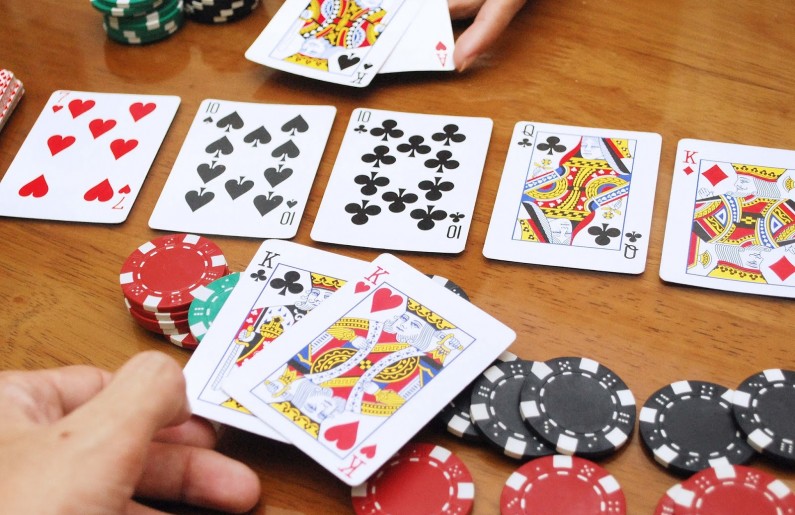Poker is a unique game that blends psychology, luck, and strategy. To succeed and profit, however, you need to understand all poker hand rankings. Only then can you assess your chances of winning at each stage, judging the odds of receiving a winning set of cards. Let’s break down the hands that can secure the pot for you.
Difference Between “Hand” and “Combination”
In conversations between players and official literature, both terms are used. There’s no strict distinction between them, so you may hear both terms even from professionals. It’s crucial to understand what’s meant by winning “hands.” If the conversation is about a favorable setup for a player with a strong hand like “Two Aces,” that’s a lucky combination. However, modern usage tends to equate these terms, though there are subtle differences between them. Let’s explore some nuances of these two popular terms in commentary.

Poker Combination
This phrase may refer to two or more words. For instance, it could mean the pair of aces mentioned above. The term can also apply to “Flush,” “Straight,” and other successful hands.
Poker Hand
This always means five cards. It could be a pair of aces paired with three potentially strong cards on the table. When the game ends, players’ combinations are analyzed, and hands are evaluated. The result determines the winner. If multiple players have identical hands, the bank is decided by the high cards in hand and on the table.
Poker Hands by Rank

High Card
A high card is one of the most common yet weakest poker hands. If no other combination exists, the hand with the highest card wins. The rank is determined in ascending order: from two to ace. Despite its weakness, a high card can still secure victory if no stronger combinations are in play. In such cases, the hand with the highest card wins. If there’s a tie, the second-highest card is considered, and so on. The kicker is crucial when two or more players have matching poker hands. This rule helps decide who takes the pot.
Pair
A pair means holding two cards of the same rank. For example, two aces. In poker, ranking by pair follows the same principle. The weakest pair is a pair of twos, and the strongest is a pair of aces. When multiple players hold pairs, the highest one wins. If pairs are tied, the kicker comes into play. When two or more players have matching poker hands, the second and third extra cards are compared.
Two Pairs
This hand consists of two pairs of different ranks on the table and in the player’s hand. For instance, two pairs of aces and kings create a “Two Pairs” hand. If several players have pairs of the same rank, the fifth card (kicker) determines the winner. Note: there’s no “three pairs” in poker. If there are three matching cards, only the two strongest pairs are counted.
Three of a Kind
Three cards of the same rank. Three identical cards are often a winning combination. If a player has a pair and another matching card appears on the table, it’s called a set. If a player has one card in hand and two matching cards appear on the table, it’s called three of a kind. Both scenarios are equally significant, though sets are easier to disguise, creating opportunities for psychological tactics against opponents. When players have the same combination, the higher card or kicker determines the winner.
Straight
Five cards in sequence on the table and in the player’s hand, regardless of suit. This is the first poker combination where all five cards are considered. If two players have a straight, the one with the higher card wins. If two identical straights are present, the pot is shared. The ace is key, as it can lead both the highest (ace, king, queen, jack, 10) and lowest (5, 4, 3, 2, ace) straights.
Flush
Five cards of the same suit, without regard to rank. If both players have a flush, the higher card wins. If the top card is tied, the second card determines the winner, and so on. If all cards are identical, the pot is split equally.
Full House
A rare combination where suit and sequence don’t matter. It consists of a pair and three cards of the same rank. In English, “Full House” translates as a “full house,” though the original term is often retained. When two players have a full house, the player with the higher card wins.
Four of a Kind
Four identical cards. This rare combination offers strong winning odds. If two players have four of a kind, the kicker determines the winner, with four aces being the highest kicker and four twos the lowest. In Texas Hold’em, four of a kind beats nearly all hands, except for a straight flush and royal flush.
Straight Flush
Five consecutive cards of the same suit. If two players have a straight flush, the one with the higher card wins. If the top card is on the table, the pot is split. This combination is a blend of a straight and a flush.
Royal Flush
The rarest and strongest hand. It consists of an ace, king, queen, jack, and ten of the same suit. There are only four possible royal flushes, ensuring the winner takes the pot. The only exception is when all five cards appear on the table, in which case the pot is split.

When Several Players Get Lucky
In poker, there is no strict hierarchy between suits. This means that two identical pairs are assigned the same rank when determining the winner. Therefore, in any form of poker, you won’t encounter a situation where a hearts combination beats an equivalent spades combination. If two or more players have identical hands, the pot is split equally among them. When identical high cards are in play, the prize pool is also distributed evenly. A straightforward and fair approach.
How to Quickly Remember Poker Hands
There are many profitable card combinations, so beginners need time to memorize them. Knowing your winning chances early on will help avoid futile bets and extra costs. Here are a few popular methods to quickly and easily memorize poker hands:
- Post them on a wall – like in school when memorizing multiplication tables. Seeing them often helps.
- Watch online tournaments with commentary – listen to experts discussing winning odds.
- Regular practice – practice frequently, ideally in an app with virtual chips.
- Poker calculator – install one that includes all poker hands and hand matrixes.
- Refer to this guide – Keep this article on “Poker Hands by Rank” handy. Review it to make sure you’re aiming for the winning hands. This article is also useful for those interested in statistics, as you’ll gain insight into the odds of getting specific hands.
To remember these winning hands, practice in a relaxed setting. Study strategies used by well-known players, and stay connected with reliable resources – your chances of winning will increase with a deeper understanding of the game.
FAQ – Frequently Asked Questions
How many poker hands are there?
Poker hands are entirely unpredictable and based purely on probability. According to statistics, there are 1,326 possible hand combinations. Poker hands are generally categorized into three types of starting hands:
- Pocket Pairs: Includes 13 different pairs, from twos to aces. There are 78 possible pair combinations, which make up about 6% of all starting hands.
- Suited Hands: Two cards of the same suit, with 312 possible combinations, or 24% of all hands.
- Off-suit Hands: Two cards of different suits, which make up 70% of hands, or 936 combinations. These hands can sometimes be unrelated or follow in sequence, increasing the odds of a straight.
Pocket pairs are less common, while suited hands appear about four times more often. However, players are most often dealt hands that don’t guarantee a specific outcome. Analyzing and selecting starting hands carefully will help reduce the number of losing rounds.
What is the strongest hand in poker?
Large pots are usually won by rarer combinations like:
- Set (Three of a Kind)
- Straight
- Flush
- Full House
While these hands aren’t the strongest, they are easier to assemble than a royal flush or four of a kind. However, having one of these hands doesn’t guarantee victory; the key is playing the hand well to maximize profit.
Why is three of a kind sometimes stronger than a straight?
A set is a favorable poker hand due to its subtlety. Only experienced players can often detect a three of a kind in their opponents’ hands. This element of psychology plays a big role. In Texas Hold’em, the odds of getting three of a kind are around 20%, while in other poker variations, the odds drop to about 5%. Although a set generally loses to a straight, in short-deck poker (6+ Hold’em), hand rankings can shift. If a straight always beat a three of a kind, it would discourage players from pursuing the straight, as it would result in a “dead” hand.
Where can I learn poker rules?
In the past, players had to learn poker combinations from experienced friends or seek specialized literature. Today, learning poker rules is easier – you only need to review our poker guides to understand hand rankings, strategy, and even the psychology of the game.



